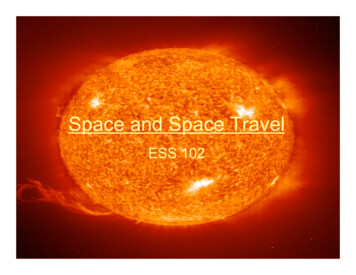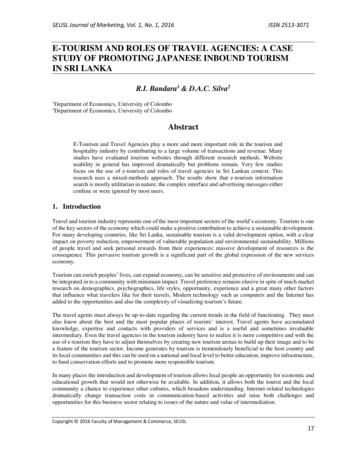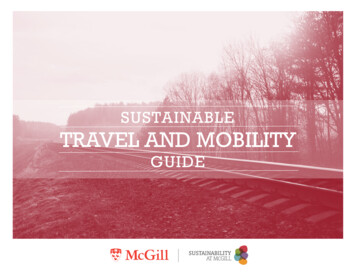
Transcription
Space and Space TravelESS 102
Instructor for today and about 20%of future lecturesDr. Jeremy Thomas (jnt@u.washington.edu,JHN 270D, 685-1777)Feel free to contact me about any aspects ofthe course.
Space and Space TravelA Reminder:There will be a tutorial on the math required for this classFriday, January 5th at 5:30PM (JHN 102)Tuesday, January 9th at 5:30PM (JHN 102)
Space and Space TravelWhy do we care about the Space Environment?1) Space is lethal and our changing atmosphere and spaceenvironment are our cocoon. X-Rays and UV radiation are (usually!) stopped in ouratmosphere. Cosmic Rays ( particles, mostly protons from Sun and Space)enter our atmosphere. 8% of our radiation exposure comes from Cosmic Rays An 12 hr airplane flight is equivalent to 1/2 a chest X-Ray Cosmic Rays important for atmospheric electric fields andlightning Cosmic Rays may produce mutations and be important forevolution.
Space and Space TravelWhy do we care about the Space Environment?2) Planetary Hazards: Space has evolved over billions of years (impacts-supernovae)3) Technology depends on space: Communications Satellites Weather Prediction (Galveston-1900, Children’s Blizzard-1888) Global Location with GPS Global Remote Sensing (deforestation, fires, pollution, ozone) WIFI world (XM, Sirius, DirectTV, etc.)
Space and Space TravelWhy do we care about Space Travel?1) We’re Explorers! Space and planetary environments are hostile to us andour robot probes. We dodged a bullet with Apollo, Russia didn’t at Mars. Weightlessness, radiation, and local conditions (Temperature,Pressure, etc.) are big concerns. Space is BIG. Current methods of travel require long periods to reach targets.Expansion of Human Habitats. Other environments in the solar system. Can we survive there? Is life (or conditions for life) present anywhere else?
Space and Space TravelWhy do we care about the Space Travel?2) Space Travel is Expensive: Space Shuttle costs 10000 per pound! “Cheap” access to space costs 1000 per pound!3) Space Travel is Inefficient and Slow: 90% of most missions is composed of fuel. Even our fastest spacecraft take years to get anywhere(Voyager 2 took 12 years to reach Neptune) We must rely on gravity once we launch
Space and Space TravelWhy do we care about the Space Travel?4) Power and Communications are Difficult: Solar power doesn’t work well in the outer solar system. Neptune is 8 hours (round trip) away by radio Communications requires large, expensive networks of radiotelescopes. (the Deep Space Network)5) New Technologies are Being Developed: Understanding what is needed requires knowing what theproblems are .
Space and Space TravelMilestones in Space Exploration(1900-1970):1) 12/17/1903: First Human Flight.2) 1/13/1920: R. Goddard Rocket Propulsion Treatise.(NY Times Blasts Goddard)4) 3/26/1926: Launch of First Liquid Fuel Rocket.5) 10/04/1957: Sputnik 1 Orbits Earth.6) 4/12/1961: Yuri Gargarin Orbits Earth.7) 12/14/1962: Mariner 2 Flys by Venus.8) 7/16/1969: Apollo 11 Lands on Moon.(NY Times Apologizes to Goddard)
Santos-Dumont Paris 1906First-flight ?
Space and Space TravelMilestones in Space Exploration (1970-2004):9) 12/15/1970: Vernera 7 Lands on Venus10) 04/19/1971: Salyut 1 is the First Space Station11) 11/14/1971: Mariner 9 Orbits Mars12) 07/20/1976: Viking 1-first long duration lander13) 04/12/1981: First Flight of Shuttle Columbia.14) 08/29/1989: Voyager 2 Reaches Neptune.15) 07/4/1997: Pathfinder Lands on Mars16) 12/17/2003: Attempt to recreate Kitty HawkFlight Fails 17) 01/4/2004: Spirit Lands on Mars18) 01/14/2005: Huygens Lands on Titan(4.5 billion times further than Kitty Hawk)
Exploring our Star System Why do it?The Copernican Principle:Any observation that suggests our position in the Universe is somehowunique or special is wrong or incomplete.What we know:We live in a star system that contains a single central Sun with severalplanets of different types orbiting it.Our Hypothesis:This is NORMAL.Is this true and what does mean?
Our Local Inventory:What makes up our star system?1)A Single central star of type “G” (yellow-dwarf).2)Two sub-stellar giant planets. (Jupiter & Saturn)3)Two icy-gas hybrid planets. (Uranus & Neptune)All of the above planets have large systems of satellites; some planetsized. (Io, Europa, Ganymede, Callisto, Titan, and Triton)4)Four much smaller rocky planets. (Mercury, Venus, Earth, & Mars)5)Two areas of failed planetary debrisa) one rock based (Asteroid Belt between Mars and Jupiter)b) one ice-based (Kuiper Belt starting at Neptunes orbit) .6)Several “Dwarf” Planets. (Pluto)7)An extended distribution of ejected debris. (Oort Cloud well pastPluto)
The Sun and the Solar SystemAny study of the solar system must start with the Sun .1) The sun contains 99.9% of all the mass in the solar system (Jupiter hasmost of the remaining 0.1%)2) The sun dominates energy (and light) production at all frequencies(except in radio waves where human activity is stronger!)3) Solar energy largely determines the temperatures of every object in thesolar system.4) Material from the Solar Atmosphere is the dominant component ofinterplanetary space.Compared to the Sun, the planets are nearly inconsequential .
NeptuneUranusSaturnThe SunDominates theSolar System.JupiterEarthSolThe places we are mostinterested in don’t add up tovery much onCallistoPluto
Exploring our Star System How andWhere?History is Written in what we see:The distribution, composition, and evolution of material in the solarsystem tells us how we got from a cold cloud of gas & dust to thepresent:1)How did the Sun form and evolve?2)How do planets form and where?3)What does the distribution of planets and debris tell us aboutthe early solar system?4)How do planets change with time and what are theprocesses involved?5)How does the interaction with the Sun affect conditions on aplanet on various time scales?6)What does our system tell us about others?
Scales in the Solar SystemThe Solar System is characterized byextremes:1)The very hot to the very cold2)The very big to the very small3)The very dense to the very tenuous4)The very close to the very distant5)The very numerous to the very unique6)The very fast to the very slow
Scientific Notation:Scientific Notation is a shorthand way of writing and multiplyinglarge (and small) numbers.0.00000000110-9Nano (n)(billionth)0.00000110-6Micro (µ)(millionth)0.00110-3Milli (m)(thousandth)1100Unity1000103Kilo (k)(thousands)1,000,000106Mega (M)(millions)1,000,000,000109Giga (G)(billions)1,000,000,000,0001012Terra (T)(trillions)To do numbers that are not divisible by ten, we multiply by anexponential number.4,275,000,000 4.275 x 109 or 0.000374 3.74 x 10-4
Using Scientific Notation:To multiply numbers using scientific notation we add theexponents.103 x 10-9 10(3) (- 9) 10-6102 x 105 10(2) (5) 107To divide numbers using scientific notation we subtract theexponents.103 10-9102 105 10(3) - (- 9) 10(2) (5) 1012 107To add or subtract numbers using scientific notation we work infront of the exponents.3.0 x102 2.6 x 1051.0 x105 - 7.0 x 102 2.603 x105 0.993 x105
(Mercury, Venus, Earth, & Mars) 5) Two areas of failed planetary debris a) one rock based (Asteroid Belt between Mars and Jupiter) b) one ice-based (Kuiper Belt starting at Neptunes orbit) . 6) Several “Dwarf” Planets. (Pluto) 7) An extended dis











